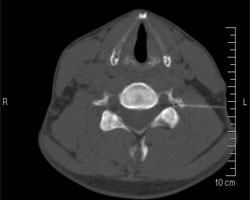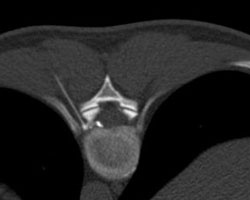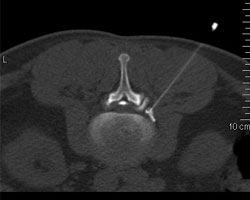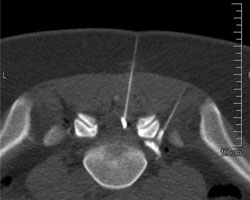CT-guided nerve root treatment, Periradicular therapy (PRT) and epidural injection
The indication for PRT consists of nerve root irritation syndromes. These arise mostly due to a herniated disc and / or narrowing of the nerve roots due to the degenerative changes of the spine (spinal stenosis = narrowing of the spinal canal / Foramenstenose = narrowing of the nerve exit point from the spine).
In rare cases, nerve root irritation syndrome occurs because of the highly degenerated intervertebral disc compartment on - without a slipped disc. This is called a chemical radiculopathy or nerve irritation syndrome.
A nerve irritation syndrome can often arise as a result of segmental instability. In a relaxed structure provides increased mobility of the vertebrae, so the nerves are irritated especially when loaded mechanically and constantly inflamed.
If there are no serious motor and sensory deficits and the conservative therapy for 2-4 weeks has not, your pain can be treated with interventional pain management. Many of herniated discs - particularly if they have occurred recently - and spontaneously shrink or with targeted treatments and smaller. Pain is treated directly, the cause of pain is increasingly blurred. Sun can avoid surgical therapy. If the micro-treatment do not achieve significant improvement in your symptoms, a surgical intervention in most cases are connected.
For the PRT to be in a supine or prone position supported on the scanner table and after the usual preparations and the establishment of the treated spinal segment is the highlight of the coordinates on the skin. Subsequently, the skin disinfected several times and then begin the treatment. Under MRT-/CT-tomographischer image control, a thin needle under local anesthesia of the skin and muscles up close to the nerve root (of nerves in the spinal canal or exit point forward). Thereafter, small amounts of injected Röntgenkonrastmitteln to ensuring that the needle tip is not in vessels or nerves, and that to achieve the injecting drugs a real Umfluten the nerve root. This makes it possible to inject drugs precisely to this nerve, spread into the spinal canal. Thus, a high local effective dose to the damaged nerve can be achieved. In addition, local anesthetic injections are injected around the nerve. Thus, the pain is usually immediately after, but a temporary numbness may occur with or without loss of strength in the legs or arms. This can last about 2-4 hours and disappears entirely.
This type of treatment is initially a twice a week and later with increasing pain relief of malignant 2-3 repeated at intervals of 2-4 weeks outpatient
|
|
PRT an der Halswirbelsäule in Rückenlage:
|
|
|
PRT an der Brustwirbelsäule in Bauchlage: Bei Bandscheibenvorfall oder generel bei Nervenreizung in der Brustwirbelsäule, ist die PRT in Brustwirbelsäue angezeigt. Dabei werden dünne Kanülen an der Nervenaustrittstelle platziert und vorsichtig Medikamenten lokal injiziert. |
|
|
PRT an der Lendenwirbelsäule von lateral: |
|
|
PRT an der Lendenwirbelsäule von epidural und lateral: |





